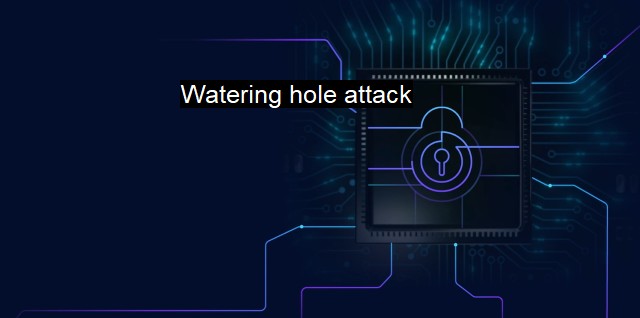What is Watering hole attack?
Watering Hole Attacks: A Devious Cyber Strategy Employed by APTs and Governments to Infiltrate Unsuspecting Users and Small Firms
The "watering hole attack" is an innovative method used by cybercriminals to compromise the operations of their target groups or individuals. Predicated on the behaviors of predators in the natural world, these adversaries strategically infect websites their targets are likely to visit, rather than attempting to breach their secure networks directly. A successful watering hole attack can give cybercriminals access to sensitive data, potentially causing financial loss and damaging reputation.In a watering hole attack, the adversary diligently studies their targets to understand their online behavior, the digital resources they use, the websites they frequently visit, their geographical location, and even their language preferences. The behavioral patterns established during this reconnaissance phase are then leveraged to identify likely 'watering holes.'
Once potential watering holes are identified, the attacker probes these websites' defenses for vulnerabilities that can be exploited. They may inject malicious code into the site’s HTML or JavaScript, or the attack may involve more elaborate and sophisticated methods such as "zero-day exploits" which can infect the visitors' systems with malware before even the developers get a chance to rectify the problem.
Like predators in the wild, the attacker quietly waits. When a visitor from the targeted organization visits the compromised website, the malware gets downloaded onto their device. It could be a ransomware, a Trojan, or a spyware; the choice of malware depends on what the attacker wants to achieve.
Once the target machine is infected, the attacker can exploit it in numerous ways. They might purloin sensitive information such as financial data, personal ID numbers (including social security numbers), and proprietary business information that gives them leverage over their victims.
Organizations reliant upon technology are at high risk of watering hole attacks, especially in sectors like technology, finance, defense, and government where adversarial intelligence capabilities can be broadly applied and exploited to devastating effect. Despite the perpetrator's chosen attack vector or specific payload, the end goal remains the same — to remain covert until achieving their mission objective.
Mitigation against watering hole attacks involves a layered security approach, with constantly updated antivirus software being one key defense. Using an antivirus system, potentially harmful anomalies such as malware can be detected and eradicated early on. This software also acts as a deterrent, discouraging cybercriminals from persisting with their incursion.
Cybercriminals are adaptable, devising ways to compromise even the most sophisticated defenses. Recognizing this, cybersecurity teams work round the clock, implementing patches and updates to guard against hitherto unknown threats, thus preventing zero-day exploits that criminals could potentially capitalize upon.
Monitoring internal traffic for abnormal behavior can help identify signs of a breach, particularly when dealing with advanced persistent threats where the danger remains over a prolonged period. Regular training and education of users are equally important since they are the first ones to interact with the compromised sites.
Companies must enforce strict security protocols. Employees should only have access to the data required for their job function, and this data should be encrypted, with two-factor authentication (2FA) employed wherever possible. Similarly, devices used by employees should be secured, with antivirus systems installed and continuously updated.
The watering hole attack is an indirect method deployed by cybercriminals, luring their victims by injecting malware into the websites they frequent. These attacks can have a devastating impact if not thwarted in time. Balancing the adoption of robust cybersecurity defenses like up-to-date antivirus software, with user education, can reduce the risk, ensuring digital integrity in a perpetually evolving cyber threat landscape.

Watering hole attack FAQs
What is a watering hole attack?
A watering hole attack is a type of cyber attack where the attacker targets a specific group of users by infecting a website that they are known to visit. The attacker compromises the website by injecting malicious code or malware, which then infects the computers of the targeted users when they visit the site.How does a watering hole attack work?
A watering hole attack works by targeting a specific group of users who are known to visit a particular website. Once the attacker has identified the website, they compromise it by injecting malicious code or malware. When the targeted users visit the infected site, their computers are infected with the malware, which can then steal their sensitive information, such as login credentials and credit card numbers.How can you protect yourself from a watering hole attack?
To protect yourself from a watering hole attack, you should keep your antivirus and security software up to date. You should also avoid visiting unfamiliar or suspicious websites, especially those that are not secure. Finally, you should be aware of the latest watering hole attacks and stay informed about the latest cybersecurity threats.What are some examples of watering hole attacks?
One example of a watering hole attack is the 2010 Aurora attacks, which targeted Google and other tech companies. Another example is the 2013 attack on several US news sites that were visited by foreign policy experts. In 2017, a watering hole attack was discovered on a website popular with Mongolian government employees.| | A | | | B | | | C | | | D | | | E | | | F | | | G | | | H | | | I | | | J | | | K | | | L | | | M | |
| | N | | | O | | | P | | | Q | | | R | | | S | | | T | | | U | | | V | | | W | | | X | | | Y | | | Z | |
| | 1 | | | 2 | | | 3 | | | 4 | | | 7 | | | 8 | | |||||||